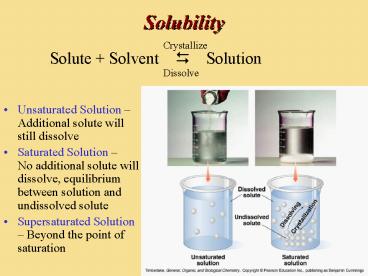Solubility - PowerPoint PPT Presentation
1 / 22
Title: Solubility
1
Solubility
Crystallize
Solute Solvent ? Solution
Dissolve
- Unsaturated Solution Additional solute will
still dissolve - Saturated Solution No additional solute will
dissolve, equilibrium between solution and
undissolved solute - Supersaturated Solution Beyond the point of
saturation
2
Salt Solubility and Health
- Sodium urate is formed from uric acid, a natural
chemical in the body. Uric acid can also come
from foods. - Uric acid in normal amounts remains dissolved in
the blood, easily passes through the kidneys and
leaves the body as waste. Uric acid in high
amounts, however, makes a person more likely to
develop gout. - Uric acid crystals deposit in the joints
- The amount of uric acid in your blood can change
depending on - What you eat red meats and internal organs (such
as liver and kidneys), some shellfish and
anchovies - Your overall health
- How much alcohol you drink
- What medicines you are taking
- Sudden illnesses
- The kidneys' ability to rid the body of uric acid
(heredity).
3
Solubility
Crystallize
Solute Solvent ? Solution
Dissolve
- Factors Affecting Solubility
- Energy Requirements
- Solvent-Solute interactions (like dissolves like)
- Temperature Effects
- Pressure Effects (Henrys Law)
4
The Solution Process
Energy Changes and Solution Formation
5
The Solution Process
Energy Changes and Solution Formation
CaCl2 example
NH4Cl example
6
The Solution Process
- Energy Changes and Solution Formation
- Breaking attractive intermolecular forces is
always endothermic. - Forming attractive intermolecular forces is
always exothermic. - To determine whether ?Hsoln is positive or
negative, we consider the strengths of all
solute-solute and solute-solvent interactions - ?H1 and ?H2 are both positive.
- ?H3 is always negative.
- It is possible to have either ?H3 gt (?H1 ?H2)
or ?H3 lt (?H1 ?H2).
7
The Solution Process
- Energy Changes and Solution Formation
- Rule polar solvents dissolve polar solutes.
Non-polar solvents dissolve non-polar solutes.
Why? - If ?Hsoln is too endothermic a solution will not
form. - NaCl in gasoline the ion-dipole forces are very
weak because gasoline is non-polar. Therefore,
the ion-dipole forces do not compensate for the
separation of ions (loss of ion-ion
interactions). - Water in octane water has strong H-bonds. There
are no attractive forces between water and octane
to compensate for the lost H-bonds when water
molecules separate.
8
Salt Solubility Examples
- Some salts have very low solubility in water and
reach saturation right away
These salts are often referred to as Insoluble
salts Ion-ion interaction are too strong to be
separated by water
9
Temperature Affects on Solubility
- Most solids increase solubility in a liquid with
increasing temperature - Most gases decrease solubility in a liquid with
increasing temperature
10
Pressure Affects on Solubility
- Solubility of liquids and solids not greatly
affected by pressure - Solubility of gases greatly affected by pressure
(Henrys Law) - Increase pressure Increase solubility
- Coca-cola example
11
Gas Solubility Application
12
Bends and Scuba DivingHenrys Law in Action
- Pressure on the body increases at the divers goes
deeper - Increased pressure increased gas in blood
- Air is mostly nitrogen so more nitrogen than
normal dissolved in our blood - As the diver ascends, the gases come out
(pressure decreases) - Fast ascends lots of bubbles (BAD for our
organs and joints!)
13
Altitude Illness- Mountain Sickness (Form of
Hypoxia)
- Most likely to be affected are mountain climbers,
pilots and persons living at high altitudes above
8,000 feet. - High altitude low pressure low oxygen
concentration dissolved in blood - In a healthy person at sea level, blood is 95
saturated with oxygen. At 18,000 feet it is only
71 saturated.
14
Ways of Expressing Concentration
- All methods involve quantifying amount of solute
per amount of solvent (or solution). - Generally amounts are measures are masses, moles
or liters. - Qualitatively solutions are dilute or
concentrated. - Definitions
15
Ways of Expressing Concentration
- Parts per million (ppm) can be expressed as 1 mg
of solute per kilogram of solution. - Parts per billion (ppb) are 1 ?g of solute per
kilogram of solution. - Proof by conversion
16
Ways of Expressing Concentration
Mole Fraction, Molarity, and Molality
17
Ways of Expressing Concentration
- Mole Fraction, Molarity, and Molality
- Converting between molarity (M) and molality (m)
requires density of solution - L of solutions to kg of solution
- kg of solution kg solvent kg solute
moles of solute kg of solvent
molality
18
Colligative Properties
- Colligative properties depend on quantity of
solute molecules. - Freezing point depression
- Boiling point elevation
19
- Lowering the Vapor Pressure
- Non-volatile solvents reduce the ability of the
surface solvent molecules to escape the liquid. - Therefore, vapor pressure is lowered.
- The amount of vapor pressure lowering depends on
the amount of solute.
20
- Boiling-Point Elevation
- Non-volatile solute lowers the vapor pressure.
- Higher Temperature needed to achieve 1 atm of
vapor pressure - Freezing-Point Depression
- Non-volatile solute lowers the vapor pressure,
and shift triple point to lower temperature - Lower temperature of triple point produces lower
phase change temperature
21
Colligative Properties
- Boiling-Point Elevation
- At 1 atm (normal boiling point of pure liquid)
there is a lower vapor pressure of the solution.
Therefore, a higher temperature is required to
reach a vapor pressure of 1 atm for the solution
(?Tb). - Molal boiling-point-elevation constant, Kb,
expresses how much ?Tb changes with molality of
particles, m
22
Colligative Properties
- Freezing-Point Depression
- The solution freezes at a lower temperature (?Tf)
than the pure solvent. - Decrease in freezing point (?Tf) is directly
proportional to molality of particles (Kf is the
molal freezing-point-depression constant)































